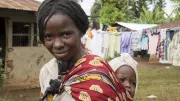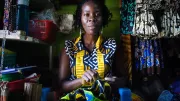Recent Blogs
Blog
Regular Savings from Irregular Income: How Platforms Can Help
CGAP partnered with fintechs and platforms across Sub-Saharan Africa to understand how they are using digital rails to offer savings products to low-income gig workers. Here, we share what we found.Blog
Stakeholder Landscaping: A Tool for Improved Consumer Engagement
Mapping the stakeholder landscape can be a useful tool to assist market conduct authorities in designing various aspects of a consumer advisory panel, ensuring they make sound strategic decisions about whom to involve and how best to do so.Blog
G2P Recipients Are Worth Competing For
Open G2P systems have great potential to connect recipients with a host of PSPs from which they can choose to receive their transfers. TymeBank realized the profitability potential of G2P customers and turned it into a core aspect of their strategy.Blog
Growing Up, Growing Informal: Gender Differences in Financial Services
Teenage men and women in Kenya and South Africa adopt formal savings accounts at similar rates. But when they hit their 20s, men continue to adopt formal services while women begin gravitating toward informal services. Why?Blog
A Tale of Two Markets
For people in sub-Saharan Africa getting by on $2-$5/day, on the cusp of poverty but not yet secured in Africa’s middle class, are economic challenges more easily weathered in formal or informal markets?Blog
Youth Programs as a Path to Financial Inclusion in South Africa
An interview with Mmapula Portia Kekana, Director for Employment Assistance at South Africa’s National Department of Social Development, which strives to link social welfare recipients to poverty alleviation programs and economic opportunities.Blog
How Absa Bank Empowered its Customers through Games
A case study from Absa Bank in South Africa demonstrates how games can help empower their customers and encourage them to use mobile financial services.Blog
Lessons on Leadership: Turning Banking Upside Down
Financial service providers shouldn't try to be all things to all customers, says Brian Richardson, founding director and CEO of South Africa-based WIZZIT. Watch the video interview for insights on how financial service providers can become more customer-centric.Blog
Prioritizing Complaints Handling with Third Party Ombudsmen
More and more countries are realizing the importance of establishing proper mechanisms for handling complaints within financial institutions and establishing proper external or third party recourse systems through ombudsman schemes.Blog
FinMark Trust and Financial Market Development in South Africa
At a time when neither the government nor the private sector in South Africa were clear about the obstacles to reaching the base of the pyramid with financial services, FinMark Trust demonstrated how an effective market facilitator can develop an evidence base to inform policy and approaches.Blog
Tailoring Formal Financial Products for the Poor
In our last post, we shared findings from the South African, Bangladeshi and Indian Financial Diaries that built the case for formal and informal financial services serving different purposes in the portfolios of the poor. We found that the two should be viewed as complements rather than alternatives to each other.Blog
Beyond the Mzansi Account in South Africa – Targeting Usage
Between 2004 and 2008 the percentage of banked South African adults increased from 46% to 63%. This feat was driven primarily by the six million Mzansi accounts that were opened over that period – two-thirds of which by people that had never before had a bank account. However, approximately 30% of these were inactive. This post explores the importance of understanding the financial needs of low income clients, and how business models need to adapt to meet those needs on an economically viable basis.Blog
How to Save Lives and Lower Fuel Consumption: Clean Cookstoves
Exposure to smoke from traditional cookstoves and open fires – the primary means of cooking and heating for nearly 3 billion people in the developing world – causes 2 million premature deaths annually, with women and children the most affected.Blog
Are Retailers Better Positioned to Offer Financial Services?
In our first post in this series on the role of consumer goods retailers in financial inclusion, we discussed how retailers are similar to MNOs in their ability to reach unbanked customers. However, the opportunity for financial inclusion via organized retail, while significant, is not present in every country and not necessarily for every type of retailer.Blog
Branchless Banking Country Notes
Over the past several months, we have taken a close look at the branchless banking industry in our focus countries.Blog
Bank-led or Mobile-led Financial Inclusion?
Payments are an optimal gateway product for financially underserved households. Unlike credit, insurance, and savings, payments do not require trust by either party.Blog
The Last Frontier for Branchless Banking: State of Play in WAEMU
Access to finance in WAEMU is very low, even by comparison to other regions of Africa. The rate of bancarization announced by the BCEAO in December 2010 was 9.5% and 12.7% of the population had an account with an MFI.Blog
Branchless Banking in South Africa
South Africa has often been used as a case study by those with an interest in financial inclusion. The country has an advanced banking infrastructure with nearly 10,000 ATMs and over 100,000 POS devices deployed.Blog
A Bold Move Toward Simplifying AML/CFT: Lessons from Mexico
Regulators around the world today are beginning to realize that the chances of expanding access through branchless banking can be very limited without reducing the account-opening requirements through agents and mobile phones. The challenge is to strike the right balance between reducing account-opening requirements while maintaining basic controls for AML/CFT.Blog










